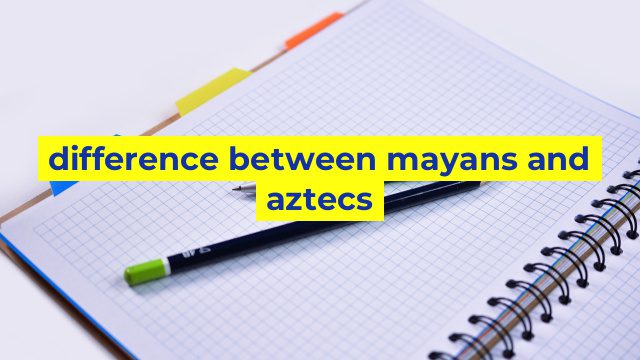The Differences Between the Mayans and Aztecs
The Mayans and Aztecs are two of the most well-known ancient civilizations in the world. Both were located in present-day Mexico and Central America, and both left an enduring mark on the region’s history and culture. However, despite sharing some similarities, the Mayan and Aztec cultures were very different from one another in several aspects.
1. Language and Writing
One of the most significant differences between the Mayans and Aztecs was their language and writing systems. The Mayans had a sophisticated system of hieroglyphics, which they used to write in books called codices. These codices recorded their history, mythology, and scientific achievements, and are some of the most important historical documents from the pre-Columbian era. In contrast, the Aztecs had a pictographic writing system that was less developed than the Mayan hieroglyphics.
2. Religion and Beliefs
Another major difference between the Mayan and Aztec cultures was their religion and beliefs. The Mayans believed in a complex system of gods and goddesses, each with its own unique characteristics and responsibilities. They also believed in the cyclical nature of time and the need to perform rituals to maintain balance and keep the gods happy. The Aztecs, on the other hand, believed in a handful of powerful gods and goddesses, with their most important god being Huitzilopochtli, the god of war and the sun. The Aztecs also practiced human sacrifice on a massive scale, which was not a significant part of Mayan religion.
3. Society and Politics
The Mayans and Aztecs also had different social and political structures. The Mayan city-states were independent of each other, and each had its own ruler or king. There was no central government or empire, and warfare between the city-states was common. In contrast, the Aztecs had a highly centralized empire, with a ruler known as the “huey tlatoani” or “great speaker.” The Aztec empire was characterized by a complex social hierarchy, with nobles, priests, and commoners occupying distinct positions in society.
4. Achievements and Legacy
Both the Mayans and Aztecs made significant contributions to the world’s cultural and scientific heritage. The Mayans developed a sophisticated calendar system and made important discoveries in astronomy, mathematics, and architecture. They also left behind impressive ruins and monuments, such as the pyramids of Chichen Itza and Tikal. Similarly, the Aztecs made impressive advancements in medicine, agriculture, and engineering. They also built impressive structures such as the Templo Mayor and practiced complex crafts like featherworking.
In conclusion, while the Mayan and Aztec cultures were geographically close and had some similarities, they were very distinct from one another in terms of language, writing, religion, society, and achievements. Each civilization had its own unique history and legacy, and continues to fascinate scholars and tourists alike to this day.
Table difference between mayans and aztecs
| Category | Mayans | Aztecs |
|---|---|---|
| Location | Central America, primarily in present-day Mexico, Honduras, and Guatemala | Mexico, primarily in the central highlands and the Gulf of Mexico region |
| Religion and beliefs | Polytheistic religion with an emphasis on agricultural and astronomical observations, human sacrifice | Polytheistic religion with an emphasis on war, human sacrifice, and the worship of specific gods |
| Social structure | Divided into city-states with a ruling elite, middle class of artisans, and slaves | Divided into city-states with a king, nobles, commoners, and slaves |
| Architecture | Pyramids, temples, and palaces adorned with intricate carvings and murals | Pyramids, temples, and palaces adorned with intricate carvings and murals, but also used adobe and sod for more mundane structures |
| Achievements | Elaborate writing system, calendar, mathematical and astronomical advancements, intricate textiles, and innovative agricultural techniques | Advanced irrigation systems, refined metalworking, and sophisticated military tactics |
